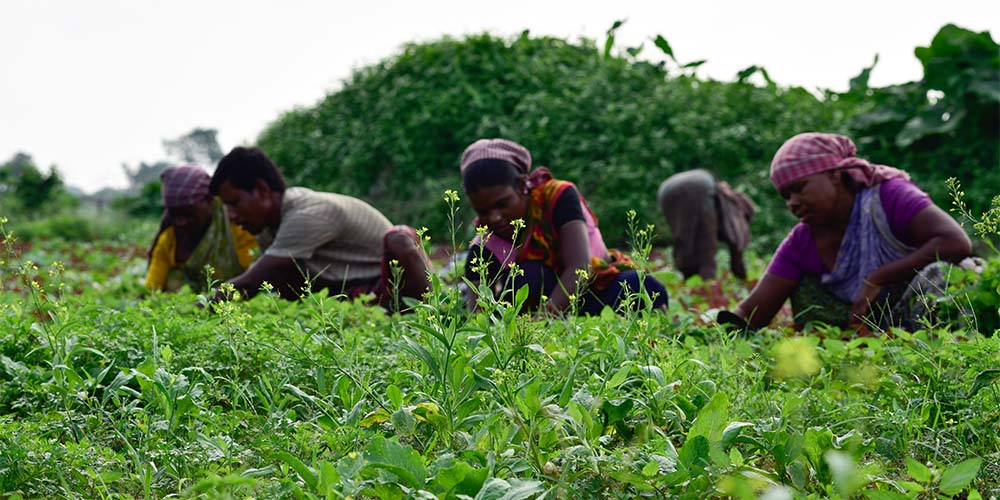Transformative Trends and Employment in Agriculture in India

Over the past five years, India’s agriculture sector has grown at an average rate of 4.18% per year, significantly contributing to the nation’s economic growth. However, with approximately 55% of the population relying on agriculture as their primary source of income, and a population of 1.4 billion, sustainability in agriculture is critical. It is essential to secure long-term productivity of land holdings, ensure sufficient farm-based incomes, and guarantee food security for the nation.
According to the National Sample Survey Office’s (NSSO) Periodic Labour Force Survey (PLFS) for 2022-2023, 45.76% of India’s workforce was employed in agriculture and related sectors. While this is a slight decrease from the previous year, it remains higher than the 42.5% recorded in 2018-2019. Agriculture employment continues to be a significant source of livelihood in India.
Union Budget 2024: A Strategic Boost for Agriculture
The Union Budget 2024 has allocated ₹1.52 lakh crore to the agriculture and allied sectors, focusing on increasing agriculture employment and skilling opportunities. Key initiatives include:
- Introduction of New Crop Varieties: The government will release 109 new varieties of field and horticulture crops that are more climate-resilient and high-yielding, ensuring better adaptability and productivity in changing environmental conditions.
- Promotion of Natural Farming: The government plans to transition one crore farmers to natural farming over the next two years, supported by certification and branding. Additionally, 10,000 bio-input resource centers will be established to facilitate this transition.
- Digital Public Infrastructure (DPI): In collaboration with states, the government will implement DPI in agriculture over the next three years. This includes conducting a digital crop survey in 400 districts in 2024 and integrating details of 6 crore farmers and their lands into centralized registries.
- Empowering Farmer-Producer Organizations (FPOs): The budget emphasizes promoting startups, cooperatives, and FPOs to improve vegetable supply chains, including aspects such as marketing, storage, and collection.
- Strengthening Agricultural Finance: The government has set an ambitious agricultural credit target of ₹20 lakh crore for 2024-25, aimed at providing farmers with easier access to credit for investing in advanced technologies and sustainable practices.
- Continued Support through the PM-KISAN Scheme: The PM-KISAN Samman Nidhi scheme remains a cornerstone of support for small and marginal farmers, with an allocation of about 1.3% of the total Union Budget.
- Enhancement of Minimum Support Price (MSP): For the 2024-25 marketing season, the MSP for all mandated Kharif crops has been increased, with significant hikes for oilseeds and pulses. This move is intended to encourage the cultivation of these crops and reduce the country’s dependency on imports.
- NABARD’s Role in Rural Development: The National Bank for Agriculture and Rural Development (NABARD) continues to play a pivotal role in providing financial support for agriculture and rural development. NABARD is launching a fund to support agri-based startups and rural enterprises, and it also finances critical rural infrastructure projects like irrigation, roads, and storage facilities this will help in increasing employment in rural areas.
Employment in Agriculture in India
The budget’s focus on digital transformation is expected to create new agriculture jobs in India in digital advisory services, supply chain management, and precision farming technologies. Easier access to credit will enable farmers to invest in modern technologies, potentially creating around 1 million agriculture jobs in India. Furthermore, NABARD’s support for agri-based startups and rural enterprises will drive employment in rural areas.
Moreover, the agriculture sector is witnessing a surge in diverse employment opportunities, particularly in areas such as agri-warehousing, new agricultural technologies, and agri-financing. In agri-warehousing, there is a growing demand for roles like warehouse managers, quality control inspectors, inventory managers, and logistics coordinators who ensure the safe storage and efficient movement of agricultural produce. With the advent of new agricultural technologies, job roles such as precision farming specialists, drone operators, IoT device technicians, data analysts, and agritech product developers are increasingly required to drive innovation and improve farm productivity. In the agri-financing domain, positions such as credit analysts, rural loan officers, financial advisors, and customer relationship managers are essential to facilitate easier access to credit and financial services for farmers and rural enterprises, contributing significantly to rural employment.
How Staffing Companies Can Bridge the Employment Gap
Staffing companies can play a pivotal role in bridging the employment gap by matching these emerging job roles with the right talent, supporting the sector’s growth and modernization
Strategies for Talent Acquisition and Retention:
Skilling Programs: Implement skilling and training initiatives to equip the workforce with modern agricultural techniques and digital skills
Incentives and Benefits: Offer competitive salaries, benefits, and career growth opportunities to retain talent in rural employment.
Work Environment: Foster a supportive and inclusive work environment to enhance employee satisfaction and retention in agriculture employment.
Conclusion
The Union Budget 2024 has laid a strong foundation for the growth and development of India’s agriculture and allied sectors. Through financial support, infrastructure enhancement, and technological integration, the government aims to create a sustainable and prosperous agricultural landscape, promoting employment in agriculture in India.
As the agriculture sector continues to evolve, the role of staffing companies like TeamLease becomes increasingly vital. We are committed to bridging the employment gap by providing skilled talent, workforce management solutions, and innovative recruitment strategies. Contact us to ensure your business is equipped with the best resources to thrive in this dynamic environment.
Latest Blogs
India’s Logistics Industry: Key Driver of Economic Development
Job Creation: Logistics expanding employment horizon India's Logistics Industry is poised for significant growth, which is expected to create millions of new jobs. By 2027,...
Read MoreRole of Contract Staffing in Green India Mission
Growing Demand for Green Skills in Green India Mission As the world moves towards a greener and more sustainable future, India also needs more green...
Read MoreBulk Hiring Made Easy with 100% Compliance Adherence
Here are a few examples of how companies are responding: Hiring for increased customer support: As more consumers buy products online as well as through...
Read MoreAsset Management Companies in India & Contract Staffing
The AMC segment attracts not only investors but also the workforce in the financial services domain. There is an increased demand for skilled professionals who...
Read MoreHousing Finance Companies in India: Opportunities and Growth
In this blog, we'll delve deep to understand how housing finance companies in India are doing and how recent government’s push might help them grow,...
Read More




